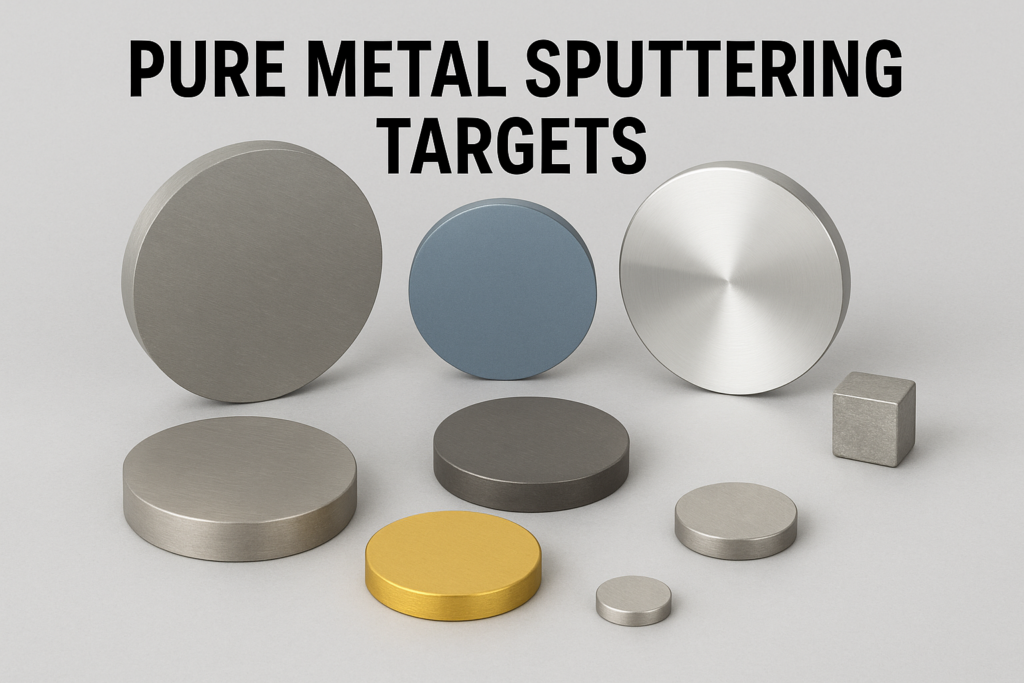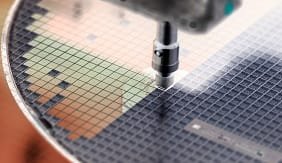1. Introduction
Sputtering is a dominant physical vapor deposition (PVD) technique used to deposit thin films with precise thickness and composition. While pure metal targets have been historically used, alloy sputtering targets have become increasingly critical due to their ability to produce films with customized electrical, mechanical, and chemical properties.
This article examines:
- Why pure metal targets are insufficient for advanced applications
- The key advantages of alloy sputtering targets
- Industries that rely on alloy targets for performance enhancements
- Future trends driving the demand for advanced alloy compositions
Understanding the necessity of alloy sputtering targets helps in appreciating their role in modern manufacturing and high-tech industries.
2. Limitations of Pure Metal Sputtering Targets

Pure metal targets, while useful for simple applications, face several critical limitations:
2.1 Limited Material Properties
- Single-element films often lack the necessary hardness, corrosion resistance, or conductivity required for advanced applications.
- Example: Pure aluminum (Al) films suffer from electromigration in semiconductor interconnects, whereas Al-Cu alloys improve reliability.
2.2 Poor Adhesion and Film Stress
- Some pure metals (e.g., Ag, Au) exhibit weak adhesion to substrates, leading to delamination.
- Alloying can modify thermal expansion coefficients, reducing stress-induced cracking.
2.3 Oxidation and Degradation Issues
- Pure metals like Cr or Ti may oxidize rapidly in certain environments.
- Alloying with elements like Al or Y enhances oxidation resistance (e.g., NiCrAlY in thermal barrier coatings).
2.4 Inability to Achieve Multi-Functional Coatings
- Many applications require films with combined properties (e.g., conductive + corrosion-resistant).
- Pure metals cannot meet such multi-functional demands, whereas alloys can.
3. Why Alloy Sputtering Targets Are Essential
3.1 Tailored Electrical and Thermal Properties
- Semiconductor Interconnects:
- Pure Cu suffers from diffusion into silicon; Cu-Mn or Cu-Al alloys act as self-forming barriers.
- Al-Si-Cu alloys reduce electromigration in microelectronics.
- Transparent Conductive Oxides (TCOs):
- Indium Tin Oxide (ITO) alloys provide optimal conductivity and transparency for displays.
3.2 Enhanced Mechanical Performance
- Wear and Corrosion Resistance:
- Ti-Al-N and Cr-N alloys are harder and more durable than pure Ti or Cr films.
- Used in cutting tools, medical implants, and aerospace components.
- High-Temperature Stability:
- Ni-based superalloys (e.g., Inconel) retain strength at extreme temperatures.
3.3 Improved Thin-Film Uniformity and Deposition Control
- Alloys with fine-grained microstructures enable more uniform sputtering.
- Example: Co-Cr-Pt alloys in magnetic storage media ensure consistent data recording.
3.4 Cost-Effectiveness and Material Optimization
- Alloying can reduce reliance on expensive materials (e.g., using Ag-Al instead of pure Ag in reflectors).
- Diluting precious metals (Au, Pt) with cheaper elements while retaining functionality.
3.5 Enabling Next-Generation Technologies
- Photovoltaics: CIGS (Cu-In-Ga-Se) alloys enable high-efficiency thin-film solar cells.
- Energy Storage: Li-Ni-Mn-Co-O (NMC) alloys improve battery electrode performance.
- Advanced Electronics: High-entropy alloys (HEAs) offer unprecedented properties for future devices.
4. Key Industries That Depend on Alloy Sputtering Targets
4.1 Semiconductor and Microelectronics

- Interconnects: Al-Cu, Cu-Mn alloys prevent electromigration.
- Barrier Layers: Ta-N, Ti-W alloys block diffusion between layers.
4.2 Optical and Display Technologies
- ITO (Indium Tin Oxide): Essential for touchscreens and OLEDs.
- Ag-Based Alloys: High-reflectivity mirrors and anti-reflective coatings.
4.3 Aerospace and Defense
- Thermal Barrier Coatings (TBCs): NiCrAlY alloys protect turbine blades.
- Wear-Resistant Coatings: Ti-Al-N extends component lifespan.
4.4 Automotive Industry
- DLC (Diamond-Like Carbon) Coatings: Reduce engine friction.
- Corrosion Protection: Zn-Ni alloys for rust-resistant coatings.
4.5 Energy and Renewable Technologies
- Thin-Film Solar Cells: CIGS alloys for efficient photovoltaics.
- Fuel Cells: Pt-Co alloys enhance catalytic activity.
4.6 Medical and Biomedical Applications
- Biocompatible Coatings: Ti-Nb-Zr alloys for implants.
- Antimicrobial Films: Ag-Cu alloys in surgical instruments.
5. Future Trends Driving Alloy Sputtering Target Development
5.1 High-Entropy Alloys (HEAs)
- Multi-component alloys (e.g., Al-Co-Cr-Fe-Ni) with exceptional strength and thermal stability.
- Potential applications in extreme environments (space, nuclear reactors).
5.2 Nanostructured and Amorphous Alloys
- Improved hardness, corrosion resistance, and magnetic properties.
- Example: Fe-based metallic glasses for high-efficiency transformers.
5.3 Sustainable and Eco-Friendly Materials
- Reducing reliance on critical raw materials (e.g., In, Co).
- Developing recyclable alloy systems.
5.4 Additive Manufacturing of Sputtering Targets
- 3D printing enables complex geometries and reduces material waste.
5.5 AI-Driven Alloy Design
- Machine learning accelerates discovery of optimal alloy compositions.
6. Conclusion
Alloy sputtering targets exist because they solve critical limitations of pure metal targets, enabling advanced functionalities in thin-film technologies. Their ability to combine multiple properties—such as conductivity, hardness, and corrosion resistance—makes them indispensable in industries ranging from semiconductors to renewable energy. As technology advances, the demand for specialized alloys (e.g., HEAs, nanostructured alloys) will continue to grow, driving innovation in material science and manufacturing.
The future of sputtering technology lies in smarter, more sustainable, and higher-performance alloy targets, ensuring their continued significance in modern industry.
Frequently Asked Questions (FAQs) about Alloy Sputtering Targets
1. What are alloy sputtering targets?
Alloy sputtering targets are composite materials made by combining two or more metallic elements to form a homogeneous target material. These are used in physical vapor deposition (PVD) processes like magnetron sputtering to deposit thin films with desired properties.
2. What is the difference between alloy sputtering targets and composite targets?
Alloy targets are formed through alloying processes where the constituent metals are fused at the atomic level, offering uniform composition. Composite targets, in contrast, are made by physically combining different materials without melting, such as by bonding or pressing powders.
3. Which deposition techniques use alloy sputtering targets?
Alloy sputtering targets are primarily used in DC and RF magnetron sputtering, ion-beam sputtering, and reactive sputtering techniques to deposit films on substrates like glass, silicon wafers, ceramics, and polymers.
4. What are the most commonly used alloys in sputtering targets?
Popular alloy materials include:
- Ti/Al (Titanium-Aluminum) for hard coatings and semiconductors
- Ni/Cr (Nickel-Chromium) for corrosion-resistant films
- Mo/Ti (Molybdenum-Titanium) for solar and optical coatings
- Cu/Zn (Brass) for decorative coatings
- Co/Cr for magnetic data storage applications
5. How are alloy sputtering targets manufactured?
Common fabrication methods include:
- Vacuum arc melting
- Hot isostatic pressing (HIP)
- Powder metallurgy
- Casting followed by forging or rolling
Each method ensures consistent alloy distribution and high material density for efficient sputtering.
6. What are the advantages of using alloy sputtering targets?
- Tailored film properties (e.g., hardness, magnetism, electrical conductivity)
- Improved adhesion and film stress control
- Enhanced corrosion and wear resistance
- Compatibility with complex multi-layer structures
7. How do you choose the right alloy target for a thin film application?
Selection depends on:
- Desired film properties (optical, electrical, mechanical)
- Substrate material
- Sputtering system parameters (power, gas, pressure)
- Application needs (e.g., semiconductors, photovoltaics, optics)
8. What are the typical purity levels for alloy sputtering targets?
Most alloy targets have purities ranging from 99.5% to 99.999% depending on the application. High-purity alloys are critical in electronics and optical devices to reduce contamination and defects.
9. Can alloy sputtering targets be customized?
Yes, manufacturers can tailor:
- Composition ratios (e.g., Ti:Al = 70:30)
- Target dimensions (thickness, diameter, shape)
- Bonding type (elastomeric, indium, solder)
- Backing plate compatibility
to meet specific project or equipment requirements.
10. What are the storage and handling precautions for alloy sputtering targets?
- Store in dry, vacuum-sealed packaging
- Avoid physical scratches or impacts
- Handle with gloves to prevent contamination
- If bonded to backing plates, avoid exposing to excessive heat or moisture

